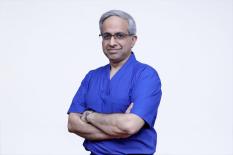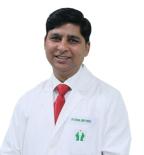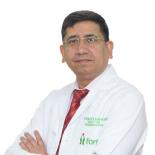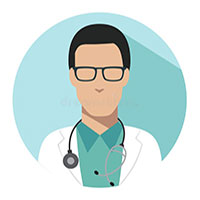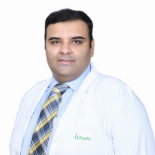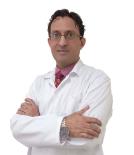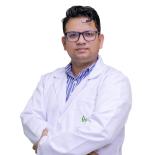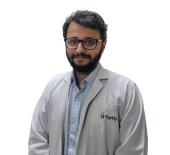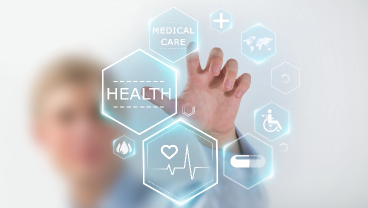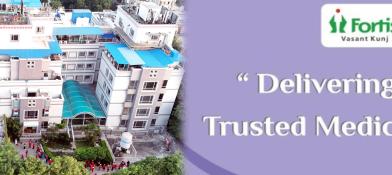About Paediatric Orthopaedics
What is paediatric orthopaedics?
Paediatric orthopaedics is a sub-branch of orthopaedics that mainly focuses on the diagnosis, treatment, and prevention of musculoskeletal disorders in children and adolescents. The physicians who treat such conditions and disorders in children are referred to as paediatric orthopaedic surgeons or paediatric orthopaedists. They mainly focus on treating infants and children below 15 years old. They treat all kinds of bone and joint disorders. They work closely with other healthcare physicians to provide comprehensive care for children with musculoskeletal disorders and injuries. Their main aim is to promote healthy growth in children by giving them proper treatment.
Conditions treated by paediatric orthopaedists
Arthrogryposis: It is a general condition where the movement of joints in children is limited. It is also known as arthrogryposis multiplex congenita (AMC). It causes stiffness of joints. Such joints are unable to move over time. The main cause of this condition is inadequate amniotic fluid. Symptoms include muscle contractures, muscle weakness, and spine curvature.
Cerebral palsy: It is a condition in which movement and muscle tone in children are affected. It is caused when there is an abnormal development or damage to the areas in the brain that control motor function. It is the most common disorder that occurs in infants and children. It is also caused due to several kinds of injuries that can damage parts of the brain. It is often not diagnosed until the age of 2 or 3. Head injuries, infections of the brain, decreased oxygen flow to the brain, malnutrition, and heavy metal injections are some of the causes of this condition. Symptoms include exaggerated reflexes, floppiness in limbs, spasticity, stiffening of trunk, arm and legs, and vision or hearing problems. Based on the part of the body affected, it is classified into three types:
- Spastic diplegia: It is a condition more likely to affect infants born preterm. It more often affects the legs than the arms.
- Spastic quadriplegia: It is a condition more likely to affect babies after delivery. It affects all four limbs.
- Spastic hemiplegia: It is a condition that occurs in children where one whole side of the body is affected.
The treatment for this condition involves:
- Therapeutic electrical stimulation (TES): It is an electrical stimulation process used to increase blood flow in the affected area.
- Baclofen: It is a muscle relaxant medication administered orally or directly to cerebrospinal fluid through a baclofen pump surgically.
- Selective dorsal rhizotomy (SDR): It is a surgical procedure involving the cutting of lumbar and sacral sensory nerve fibres in the muscles and the spinal cord.
Bone cysts: These are the non-cancerous bone tumours caused in children. These are the fluid-filled areas inside the growing bones that have not fully developed. The common symptoms include bone fractures and weak bones. It has the following types:
Nonossifying fibromas: It is a condition where a central portion of a bone is fibrous in nature and does not form into a hard bone. It is most commonly seen in children between 5 and 15 of age.
Fibrous defects: It is a benign bone lesion commonly seen in the lower extremities.
Unicameral bone cysts: It is a condition that occurs in large bones, like the humerus. The lesions here are fluid-filled sites.
Aneurysmal bone cysts: These are the blood-filled sites of bones seen in adolescents or teenagers. They cause pain and swelling in the affected areas.
Internal tibial torsion: It is a condition of inward twisting of the tibia, the larger bone in the lower leg, leading to the in-toeing of the foot. It is seen in children at the initial stages of walking. It affects both legs of a child. Common symptoms include femoral anteversion (twisting of the hip bone) and metatarsus adducts (curved foot). This condition improves without treatment in some cases, but bracing, casting, and physical therapy might also be needed. If it is not healed, then treatments like surgery, called tibial derotational osteotomy, are performed. It is a surgical procedure where the tibia is cut, rotated, and fixed in a straight procedure.
Osteomyelitis: It is an inflammation of bone tissues, causing swelling of bones, and is caused due to an infection. It occurs for various reasons, like bacterial bloodstream infections that spread to the bones, infections due to traumatic injury, and some medications. It is seen in children with a weak immune system. It is also seen in infants, wherein it affects long bones like the femur and humerus. The main source of infection is the staphylococcus aureus bacteria.
Achondroplasia: It is a genetic condition wherein a protein in the body called fibroblast growth factor receptor is affected in children. In this condition, this protein functions normally, slowing down the growth of cartilage in the bones. This results in shorter and abnormally shaped bones. It causes neurological impairments in children. As it is a genetic condition, it is passed from parents to children. It is due to a mutation that occurs in the embryo. Symptoms include shortened legs and arms, large-sized heads, misaligned teeth, curved lower spine, bowed lower legs, flat feet, trident hand (more space between middle and ring fingers), middle ear infections, and delayed development.
Marfan syndrome: Marfan syndrome is a genetic disorder of the connective tissue, affecting the skeleton, limbs, eyes, heart, blood vessels, and several organs of the body. It is generally caused due to a defective fibrillin-1 protein, which is present in the connective tissue. This results in increased production of another protein, transforming growth factor beta. So, the overproduction of this protein leads to Marfan syndrome. This condition mainly affects the skeletal and cardiovascular systems. In the cardiovascular system, it leads to a wider and fragile aorta, which leads to a dissection of the aortic wall. It causes spine curvature and an abnormally shaped chest. It is often diagnosed by ECG, slit-lamp examination, skeletal examination, and genetic tests. The treatment for this condition includes an echocardiogram to monitor the size of the aorta, beta blockers to lower the blood pressure, and antibiotics.
Neurofibromatosis: It is a genetic condition that leads to the formation of tumours in the body. Various types of neurofibromatosis include:
- Neurofibromas: It causes multiple lumps on the skin of children, which may be painful and itchy.
- Vesticular schwannomas: It causes disrupted hearing, as it affects the nerves of the inner ear.
- Schwannomatosis: It leads to the formation of painful tumours called schwannomas that cause pain, tingling, and weakness. Symptoms include painful tumours, issues in development and puberty, and hearing loss.
Signs and symptoms of ortho diseases
The common signs and symptoms that a parent must look out for include:
- Dizziness
- Syncope (losing consciousness)
- Nausea and vomiting
- Tachycardia (increased heartbeat)
- Dyspnoea (shortness of breath)
- Headaches and fatigue
- Blurred vision
- Tremors (shaking of hands and legs)
- Confusions
- Migraines (severe headaches)
- Paraesthesia (numbness in hands, face, and legs)
- Rhythmic trembling of legs and arms
- Dehydration
- Loss of blood volume
- Arrhythmias
What to expect when you meet a paediatric orthopaedist?
- When you meet paediatric orthopaedics, carry the medical records of your child, make sure to analyse the symptoms that your child is suffering from, and tell the doctor about the exact symptoms.
- The doctor asks for the medical history of your child, such as birth, age, family history, previous diseases, surgeries or injuries, and current symptoms.
- After that, physical examinations are performed by checking the pulse rate, breathing, posture, movement, and bones and joints.
- In complex conditions, the physician orders diagnostic tests like X-rays, MRI scans, and CT scans to evaluate the internal organs of the affected areas.
- Then, the results of the tests are evaluated by the physician and are discussed with you to inform you about the current condition of your child and to plan the treatment.
- They discuss various treatment options with you so you can decide the best treatment available, which might include surgeries, medications, or conservative management, like physical therapy and bracing.
- You can also feel free to ask if you have any questions regarding the issues or treatments.
- Once you decide on the treatment plans, you are asked to make follow-up appointments to monitor your child’s progress to the treatments.
Benefits of early detection of paediatric ortho problems
Early detection of paediatric ortho issues always helps your baby’s health. It offers a clean developmental history along with a healthy future for your baby. Some of the benefits of early detection of baby’s bone health issues are as follows:
- Optimal growth and development: Bones are an important factor in a baby’s growth and development. Identifying issues early in the children would offer safer and better therapy plans. This ensures that the baby achieves normal physical development appropriate to the age.
- Improved outcomes: Baby’s bones are fragile, but at the same time, they have developmental cells that offer improved outcomes after the therapy. However, early detection and intervention often lead to optimal functional mobility.
- Decreased surgical needs: Though some paediatric ortho issues can be corrected only via surgeries, early detection and intervention reduce the complexity of the surgery. This allows better recovery and a wide range of motions.
- Preventing complications: Certain congenital ortho defects, if left untreated, can lead to permanent, irreversible defects, which remain throughout life. Early detection of the congenital defects would result in an earlier treatment and prevent complications. This also goes well for acquired fractures, which, if left untreated, can lead to a permanent defect.
- Economical: If the baby’s condition is detected early, it prevents the requirement of long-run costs and a series of surgeries.
- Education and awareness: Early detection and treatment help parents to understand the baby’s conditions better. This improves baby care by promoting adherence to the therapy plans.
- Comprehensive care: Early detection by the paediatric orthopaedic surgeon offers complete comprehensive care to the baby. This includes frequent evaluation, progress analysis, and therapy plan changes.
How team fortis helps you after a paediatric ortho surgery?
Fortis Healthcare is one of the best orthopaedic hospitals that offers extensive care to support both the baby and the parents or caregivers after paediatric orthopaedic surgery. They include:
- Multidisciplinary care: The team includes paediatric orthopaedic surgeons, nursing staff, and physiotherapists who work together closely to take care of the baby post-surgery. We will be there to take care of each and every step after the surgery.
- Individualisation of care: The team offers personalised therapy for each patient. Tailored therapy plans will be designed in order to obtain the best possible outcomes post-surgery. Additionally, personalised rehabilitation practices will be performed in order to ensure better mobility post-operation.
- Pain management: Pain is the most important factor after an orthopaedic surgery. We have specialised doctors and surgeons who can manage the pain effectively, ensuring the child’s comfort during the recovery post-surgery.
- Regular follow-up visits: We schedule a regular follow-up appointment with the operating surgeon to assess the progress of the surgery and the requirement for alterations in the therapy plans.
- Education and support for parents: Caregivers will be counselled thoroughly by the doctors and surgeons after the surgery about the do’s and don’ts at home. Orthopaedic surgeons will also advise the caregivers to watch for any signs of complications.
- Nutritional support: Diet is the key to recovery. The child’s dietary habits will be taken care of by the dietician who works alongside the orthopaedic surgeon.
Conclusion
In conclusion, Fortis Healthcare stands out as the best paediatric orthopaedic hospital by providing comprehensive, individualised care to the child and parents. With a multidisciplinary care approach, Fortis Hospital comprises a team of paediatric orthopaedics, physiotherapists, nursing staff, and dieticians. Baby’s bone health is put at the forefront, prioritising their optimal growth and development.
Our Team of Experts
View allMedical Procedures for Paediatric Orthopaedics
View allBreakthrough Cases
View allOur patient’s stories
View allRelated Specialities
Other Specialities
-
Explore Hospitals for Paediatric Orthopaedics
Fortis Escorts Heart Institute, New Delhi Fortis Flt. Lt. Rajan Dhall Hospital, Vasant Kunj Fortis Hospital, Ludhiana Fortis Hospital, Richmond Road, Bengaluru Fortis Hospital, Shalimar Bagh, New Delhi Fortis Hospital, Mulund, Mumbai Fortis Hospital - Greater Noida Hiranandani Fortis Hospital, Vashi, Mumbai Fortis Hospital CG Road Bangalore Fortis Nagarbhavi Bangalore -
Explore Doctors for Paediatric Orthopaedics by Hospital
Doctors in Fortis Escorts Heart Institute, New Delhi Doctors in Fortis Flt. Lt. Rajan Dhall Hospital, Vasant Kunj Doctors in Fortis Hospital, Ludhiana Doctors in Fortis Hospital, Richmond Road, Bengaluru Doctors in Fortis Hospital, Shalimar Bagh, New Delhi Doctors in Fortis Hospital, Mulund, Mumbai Doctors in Fortis Hospital - Greater Noida Doctors in Hiranandani Fortis Hospital, Vashi, Mumbai Doctors in Fortis Hospital CG Road Bangalore Doctors in Fortis Nagarbhavi Bangalore


